Reflective Collimators, Protected Silver Coating
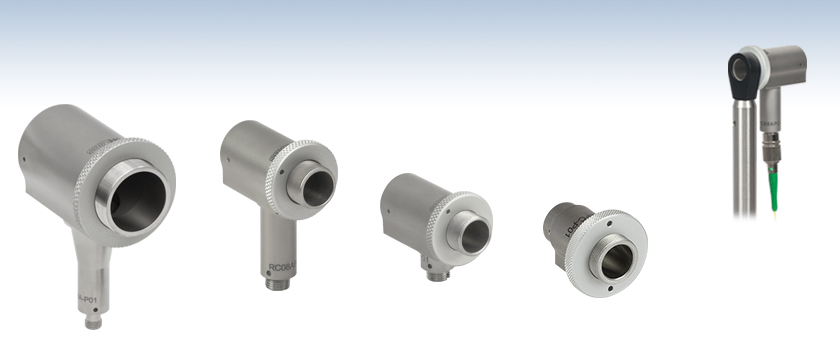
- Protected-Silver-Coated Collimators/Couplers with Reflected Focal Lengths of 7.0 mm, 15.0 mm, 33.0 mm, or 50.8 mm
- Maximum Fiber NA without Clipping the Beam: 0.40, 0.30, 0.15, or 0.19
- Free From Chromatic Aberrations
RC12SMA-P01
SMA Connector
RC08APC-P01
FC/APC Connector
RC04FC-P01
FC/PC Connector
RC02FC-P01
FC/PC Connector
RC08APC-P01
Reflective Collimator
with Patch Cable
Shown Mounted
to an LMR05 on a Ø1/2" Post

Please Wait
| Key Specificationsa | ||||
|---|---|---|---|---|
| Item # Prefix | RC02 | RC04 | RC08 | RC12 |
| Max Fiber Numerical Aperture (NA) | 0.40 | 0.30 | 0.15 | 0.19 |
| Reflected Focal Length (RFL) | 7.0 mm | 15.0 mm | 33.0 mm | 50.8 mm |
| External Threading of Housing | SM05 (0.535"-40) | SM1 (1.035"-40) | ||
| Clear Aperture | Ø7.5 mm | Ø11.0 mm | Ø22.0 mm | |
| Reflectance (Avg., AOI = 45°) | >97% (450 nm - 2 μm) >95% (2 - 20 μm) |
|||
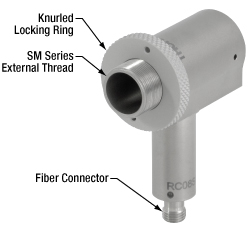
Click to Enlarge
The housings of the RC02, RC04, and RC08 collimators have SM05 (0.535"-40) external threads while the RC12 collimator has SM1 (1.035"-40) external threads. A knurled locking ring included with all collimators enables secure mounting of the optic. Please see the Mounting Options tab for details.
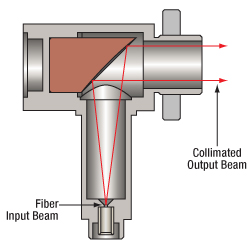
Click to Enlarge
Collimated Light from an Optical Fiber Using an RCxx-P01 Series Collimator (These collimators can also be used in reverse for coupling into a multimode fiber.)
Features
- Free from Chromatic Aberations for Collimation Over the Mirror's Reflection Band
- Protected Silver Coating (450 nm - 20 µm) Offers High Reflection
- Ravg > 97% (450 nm - 2 µm) at 45° AOI
- Ravg > 95% (2 µm - 20 µm) at 45° AOI
- Reflected Focal Lengths of 7.0 mm, 15.0 mm, 33.0 mm, or 50.8 mm
- Great for Coupling Polychromatic Light into Multimode Fiber
- FC/PC, FC/APC, or SMA Connector Options Available
- Surface Roughness: <100 Å (RMS)
- Ø7.5 mm, Ø11.0 mm, or Ø22.0 mm Clear Aperture
- Maximum Fiber NA without Clipping the Beam: 0.40, 0.30, 0.15 or 0.19 (RC02x-P01, RC04x-P01,
RC08x-P01 or RC12x-P01, Respectively) - Non-Magnetic Stainless Steel Housing
Thorlabs' Protected Silver Reflective Collimators are based on 90° off-axis parabolic (OAP) mirrors. These protected silver mirrors, unlike lenses, have focal lengths that remain constant and offer excellent reflectivity within the 450 nm - 20 µm wavelength range (please see the Specs tab for more details). Due to this intrinsic property, parabolic mirror collimators do not need to be adjusted to accommodate various wavelengths of light, making them ideal for use in systems with polychromatic light in the visible and IR.
Common applications include collimating polychromatic light emitted from a single-mode or multimode optical fiber and coupling polychromatic collimated light into single-mode or multimode fiber. When collimating light from a single-mode or multimode patch cable, the fiber numerical aperture (NA) should be ≤0.40 (RC02), ≤0.30 (RC04), ≤0.15 (RC08), or ≤0.19 (RC12) to avoid clipping light on the housing. Note too that, in general, light from a multimode fiber cannot be well collimated. For more information on how to optimize coupling of light from an optical fiber, please see the Collimation Tutorial tab.
Scattering from the mirror surface is minimal (<2% @ 633 nm) and results from the <100 Å RMS surface roughness achieved by the diamond turning process used to manufacture the off-axis parabolic mirror.
The RC02, RC04, and RC08 reflective collimator housings are equipped with external SM05 (0.535"-40) threads while the RC12 collimator housing has external SM1 (1.035"-40) threads. Thus, these mounts are directly compatible with our SM05- or SM1-threaded optomechanics such as the LMR05(/M) or LMR1(/M) lens mounts, respectively. The back of the RC02 collimators are machined down to Ø1/2", enabling direct mounting into a Ø1/2" kinematic mount. Furthermore, the RC02, RC04, and RC08 may be directly mounted to Ø1" kinematic mounts by removing the knurled ring on the front of the housing, holding the housing behind the kinematic mount's Ø1" counterbore, and then rethreading the knurled ring over the back lip of the counterbore and onto the housing by using an SPW909 Spanner Wrench or an SPW801 Adjustable Spanner Wrench. The collimator can then be secured by tightening the mount's setscrew. Please see the Mounting Options tab for more details.
Thorlabs also offers a line of UV-Enhanced Aluminum Coating Reflective Collimators for the
Fiber Patch Cables for Reflective Collimators
Thorlabs offers single mode, polarization-maintaining, or multimode fiber optic patch cables for both coupling and collimating applications. If you cannot find the appropriate stock patch cable for your application, custom-connectorized patch cables with same-day shipping are also available.
The RCxxAPC-P01 and RCxxFC-P01 collimators are constructed with 2.2 mm wide-key FC/APC or FC/PC connectors, respectively. The wide key accepts both wide and narrow key connectors; however, using a narrow-key connector in a wide-key slot will allow the connector to rotate slightly in the mating sleeve.
| Specifications | ||||||||||||
|---|---|---|---|---|---|---|---|---|---|---|---|---|
| Item # Prefix | RC02 | RC04 | RC08 | RC12 | ||||||||
| Fiber Connector | FC/PC | FC/APC | SMA | FC/PC | FC/APC | SMA | FC/PC | FC/APC | SMA | FC/PC | FC/APC | SMA |
| Clear Aperture | Ø7.5 mm | Ø11.0 mm | Ø11.0 mm | Ø22.0 mm | ||||||||
| Typical Collimated Beam Diameter (1/e2)a |
Ø1.5 mm (SM400 at 450 nm) Ø1.3 mm (SM600 at 633 nm) Ø1.5 mm (780HP at 780 nm) Ø1.3 mm (SMF-28-J9 at 1550 nm) Ø2.2 mm (SM1950 at 2 µm) |
Ø3.1 mm (SM400 at 450 nm) Ø2.8 mm (SM600 at 633 nm) Ø3.3 mm (780HP at 780 nm) Ø2.9 mm (SMF-28-J9 at 1550 nm) Ø4.7 mm (SM1950 at 2 µm) |
Ø6.8 mm (SM400 at 450 nm) Ø6.2 mm (SM600 at 633 nm) Ø7.2 mm (780HP at 780 nm) Ø6.3 mm (SMF-28-J9 at 1550 nm) Ø10.2 mm (SM1950 at 2 µm) |
Ø10.5 mm (SM400 at 450 nm) Ø9.5 mm (SM600 at 633 nm) Ø11.0 mm (780HP at 780 nm) Ø9.6 mm (SMF-28-J9 at 1550 nm) Ø15.8 mm (SM1950 at 2 µm) |
||||||||
| Full Angle Beam Divergenceb | 0.023° (SM400 at 450 nm) 0.035° (SM600 at 633 nm) 0.037° (780HP at 780 nm) 0.088° (SMF-28-J9 at 1550 nm) 0.067° (SM1950 at 2 µm) |
0.011° (SM400 at 450 nm) 0.016° (SM600 at 633 nm) 0.018° (780HP at 780 nm) 0.040° (SMF-28-J9 at 1550 nm) 0.031° (SM1950 at 2 µm) |
0.005° (SM400 at 450 nm) 0.007° (SM600 at 633 nm) 0.008° (780HP at 780 nm) 0.018° (SMF-28-J9 at 1550 nm) 0.014° (SM1950 at 2 µm) |
0.003° (SM400 at 450 nm) 0.005° (SM600 at 633 nm) 0.005° (780HP at 780 nm) 0.012° (SMF-28-J9 at 1550 nm) 0.009° (SM1950 at 2 µm) |
||||||||
| Maximum Fiber Numerical Aperture (NA) |
0.40 | 0.30 | 0.15 | 0.19 | ||||||||
| Reflected Focal Length (RFL) | 7.0 mm | 15.0 mm | 33.0 mm | 50.8 mm | ||||||||
| Parent Focal Length (PFL)c | 3.5 mm | 7.5 mm | 16.5 mm | 25.4 mm | ||||||||
| Coating | Protected Silver | |||||||||||
| Wavelength Range | 450 nm - 20 µm | |||||||||||
| Reflectance (Avg., AOI = 45°) | >97% (0.45 - 2 µm) >95% (2 - 20 µm) |
|||||||||||
| Surface Quality | 40-20 Scratch-Dig | |||||||||||
| Surface Roughness | <100 Å RMS | |||||||||||
| Reflected Wavefront Error | λ/4 RMS at 633 nm | |||||||||||
| Pointing Errord | <10 mrad | <10 mrad | - | <10 mrad | <10 mrad | - | <10 mrad | <10 mrad | - | <10 mrad | <10 mrad | - |
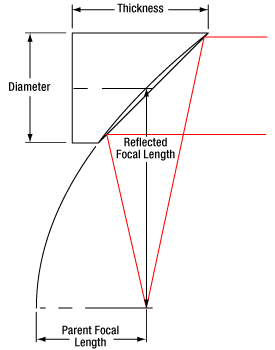
Click to Enlarge
Features of an Off-Axis Parabolic (OAP) Mirror
Mirror Mounts
The Ø1", 4.0 mm thick knurled locking ring of the RC02x, RC04x, and RC08x reflective collimators can be used as the mounting surface to secure the collimator into a mirror mount for Ø1" optics, such as the POLARIS-K1E Ø1" side optic retention mount shown in the middle image below. Other mirror mounts or other optic mounts capable of securing a 4.0 mm thick optic can also be used. The RC02x, RC04x, and RC08x collimators feature an SM05 (0.535"-40) external threading which also enables mounting to Thorlabs' SM05-threaded kinematic mirror mounts. The RC12x collimator features an external SM1 (1.035"-40) threading that can be used to mount the collimator to an SM1-threaded kinematic mirror mount or to a mirror mount for Ø2" optics by using an SM1-threaded adapter such as the AD2T adapter. The RC02x collimator can be mounted using the Ø1/2" (12.7 mm) rear surface as shown in the image below.
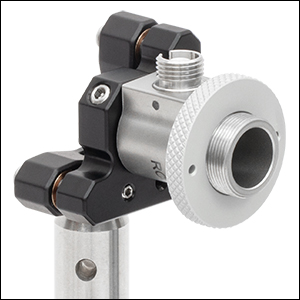
Click to Enlarge An RC02x Collimator Secured in a KM05 Kinematic Mirror Mount using the rear mounting surface.
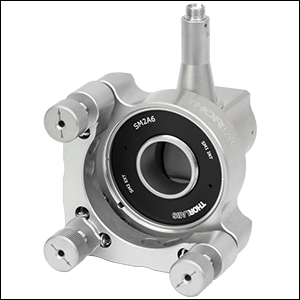
Click to Enlarge An RC12x Collimator in a POLARIS-K2T Ø2" Mount using an SM2A6 adapter with SM1-internal and SM2-external threads.
Cage System and Lens Tube Integration
The RC02x, RC04x, and RC08x collimators can be directly integrated into a cage system using the external SM05 (0.535"-40) threading on the collimator housing and an SM05 internally threaded cage component such as Thorlabs' CP32(/M) cage plate for 30 mm cage systems. Similarly, the RC12x collimator can be directly mounted into a cage system using the external SM1 (1.035"-40) threading on the collimator housing and a compatible cage system component such as the CP33(/M) cage plate for 30 mm cage systems.
The SM05 (0.535"-40) or SM1 (1.035"-40) external threading on the RC0x or RC12x collimators, respectively, can also be used to mount a compatible SM-threaded lens tube or other compatible optic for easy system integration.
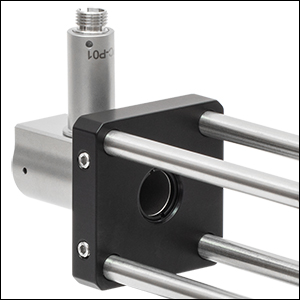
Click to Enlarge An RC08x Reflective Collimator is mounted to a CP32 30 mm Cage Plate using the SM05 (0.535"-40) external threads.
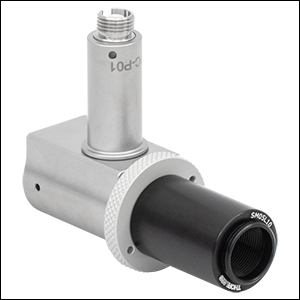
Click to Enlarge An RC08x Reflective Collimator with an SM05L10 Lens Tube attached using the SM05 (0.535"-40) external threads.
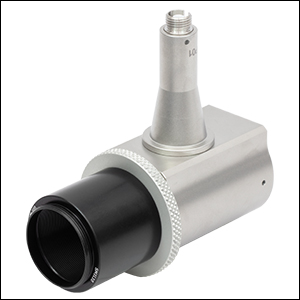
Click to Enlarge An RC12x Reflective Collimator with an SM1L10 Lens Tube attached using the SM1 (1.035"-40) external threads.
Collimating Light Tutorial
Collimating Light from a Single Mode Fiber with a Reflective Collimator
When collimating light from single-mode fibers, the Reflective Fiber Collimators produce beams with large waist diameters and low divergence. The graphs below illustrate the theoretical 1/e2 beam diameter as a function of propagation distance for four different SM fiber-coupled laser wavelengths using our reflective collimators. The effect of changing the fiber or the wavelength can be estimated using the theoretical approximations below.
Theoretical Approximation of the Divergence Angle of an Output Beam
The divergence angle can be approximated theoretically using the formula below as long as the light emerging from the fiber has a Gaussian intensity profile. Therefore, the formula works well for single mode (SM) fibers.
The full divergence angle of the output beam using an SM fiber in degrees is approximated by

where θSM is the divergence angle of the beam after collimation, MFD is the mode field diameter of the fiber, and RFL is the reflected focal length of the reflective collimator. The MFD and RFL must have the same units in this equation.
Example Calculation:
When the RC04APC-P01 collimator (RFL = 15.0 mm) is used with the P3-630A-FC-1 SM patch cable (MFD = 4.3 µm), the divergence angle is:
θSM ≈ (0.0043 mm / 15.0 mm) x (180 / 3.1416) ≈ 0.016° or 0.29 mrad.
Theoretical Approximation of the Output Beam Diameter
The 1/e2 output beam diameter can be found using the approximation

where λ is the wavelength of light being used, MFD is the mode field diameter of the fiber, and RFL is the reflected focal length of the reflective collimator.
Example Calculation:
When the RC04APC-P01 collimator (RFL = 15.0 mm) is used with the P3-630A-FC-1 SM patch cable (MFD = 4.3 µm) at λ = 633 nm = 0.633 µm, the output beam diameter is:
d = 4 x 0.633 µm x [15.0 mm / (3.1416 x 4.3 µm)] = 2.8 mm.
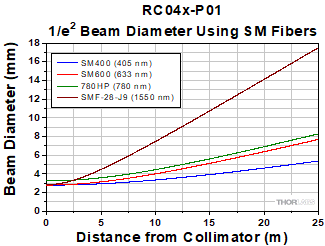
Click to Enlarge
Click Here for Theoretical Data
This data is calculated for our SM400, SM600, 780HP, and SMF-28-J9 single mode fibers and our RC04x-P01 reflective collimators.
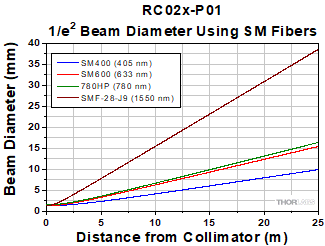
Click to Enlarge
Click Here for Theoretical Data
This data is calculated for our SM400, SM600, 780HP, and
SMF-28-J9 single mode fibers and our RC02x-P01 reflective collimators.
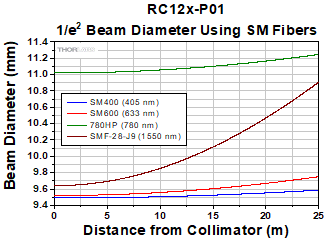
Click to Enlarge
Click Here for Theoretical Data
This data is calculated for our SM400, SM600, 780HP, and
SMF-28-J9 single mode fibers and our RC12x-P01 reflective collimators.
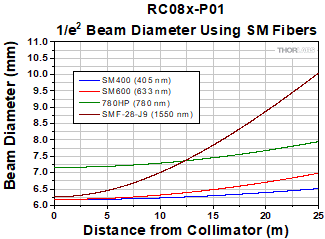
Click to Enlarge
Click Here for Theoretical Data
This data is calculated for our SM400, SM600, 780HP, and
SMF-28-J9 single mode fibers and our RC08x-P01 reflective collimators.
Collimating Light from a Multimode Fiber with a Reflective Collimator
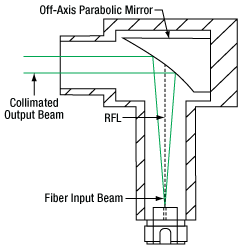
Click to Enlarge
Low-NA Fiber: The green line indicates the envelope of the beam as it diverges and is collimated by the OAP mirror.
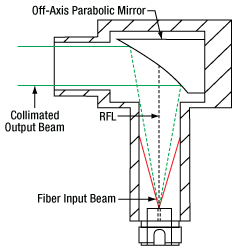
Click to Enlarge
High-NA Fiber: The red line indicates the envelope of the beam that is clipped by the collimator housing. The dashed green line shows the portion of the beam that is collimated by the OAP mirror.
The geometrical ray model can be used to describe the collimation of light from multimode (MM) fibers. Consider an off-axis point on the MM core. Light from this point will generate a collimated beam at an angle to the optical axis of the off-axis parabolic (OAP) mirror. Superimposing beams from all points on the MM core results in an output beam with significant divergence, unlike the output from the SM fiber described above. The graphs below show the calculated beam diameter as a function of distance from the reflective couplers for three different MM fibers.
Theoretical Approximation of the Divergence Angle of an Output Beam
The full angle divergence of an output beam generated from a MM fiber can be approximated with the help of the reflected focal length (RFL) of the reflective collimator and the core diameter of the MM fiber as follows:

where θMM is the divergence angle of the beam after collimation, calculated in degrees.
Example Calculation:
When the RC12SMA-P01 collimator (RFL = 50.8 mm) is used with the M96L01 MM patch cable (Core Diameter = 105 µm), the full divergence angle is:
θMM ≈ (0.105 mm / 50.8 mm) x (180 / 3.1416) ≈ 0.118° or 2.1 mrad.
Theoretical Approximation of the Output Beam Diameter
Based on the ray model, the beam diameter as a function of distance from the reflective collimator and NA can be approximated with the following relation:

The equation above shows that the beam diameter is more strongly affected by the numerical aperture (NA) of the fiber close to the reflecting mirror, whereas the core diameter more strongly affects the beam diameter far from the collimator.
The graphs below illustrate the approximated beam diameter as a function of the distance from the collimator for three different MM fibers (FG010LDA, FG025LJA, FG105LVA), all with an NA = 0.1. These results are independent of wavelength and connector type, but depend on the reflected focal length of the collimator.
Using MM fibers with NAs >0.40, >0.30, >0.15, and >0.19 for the RC02x-P01, RC04x-P01, RC08x-P01, and RC12x-P01 collimators, respectively, will cause light to be clipped by the housing of the collimators before it reaches the output. Therefore, when collimating light from a MM patch cable, the fiber NA should be ≤0.40, ≤0.30, ≤0.15, and ≤0.19 for the RC02x-P01, RC04x-P01, RC08x-P01, or RC12x-P01 collimators, respectively, to avoid clipping light on the housing.
Aside from all these considerations based on simple paraxial optics, please keep in mind that a perfect off-axis parabola can only collimate light without aberrations from a point source, located at the mirror's focal point. The further the point is away from the optical axis or the larger the core of the MM fiber, the larger the introduced optical aberrations for the off-axis rays of the extended source. Finally, the off-axis points of the extended source cannot be perfectly collimated. The effects of aberrations can, however, be minimized by increasing the reflected focal length of the reflective collimator or by increasing the wavelength.
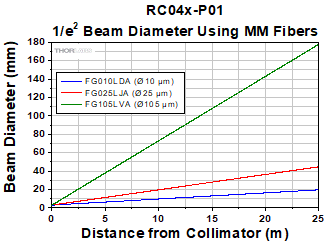
Click to Enlarge
Click Here for Theoretical Data
This data is calculated for our FG010LDA, FG025LJA, and FG105LVA multimode fibers and our RC04x-P01 reflective collimators, independent of wavelength.
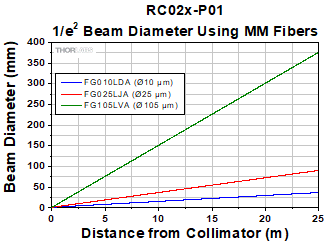
Click to Enlarge
Click Here for Theoretical Data
This data is calculated for our FG010LDA, FG025LJA, and FG105LVA multimode fibers and our RC02x-P01 reflective collimators, independent of wavelength.
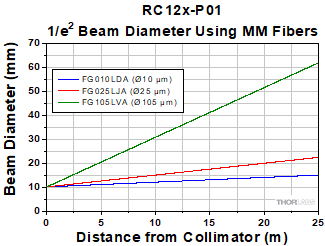
Click to Enlarge
Click Here for Theoretical Data
This data is calculated for our FG010LDA, FG025LJA, and FG105LVA multimode fibers and our RC12x-P01 reflective collimators, independent of wavelength.
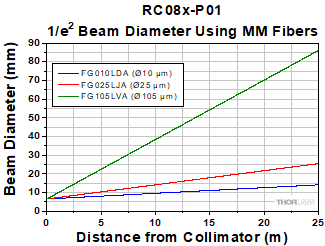
Click to Enlarge
Click Here for Theoretical Data
This data is calculated for our FG010LDA, FG025LJA, and FG105LVA multimode fibers and our RC08x-P01 reflective collimators, independent of wavelength.
Insights into Off-Axis Parabolic Mirrors
Scroll down to read about the unique properties of off-axis parabolic (OAP) mirrors and how to take advantage of them:
- Why a Parabolic Mirror Instead of a Spherical Mirror?
- Benefit of an Off-Axis Parabolic Mirror
- Directionality of OAP-Mirror-Based Reflective Collimators
Click here for more insights into lab practices and equipment.
Why a Parabolic Mirror Instead of a Spherical Mirror?
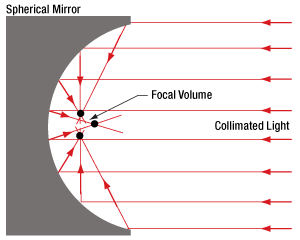
Click to Enlarge
Figure 2: Spherical mirrors do not reflect all rays in a collimated beam through a single point. A selection of intersections in the focal volume are indicated by black dots.
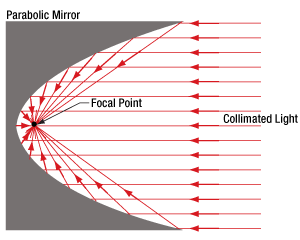
Click to Enlarge
Figure 1: Parabolic mirrors have a single focal point for all rays in a collimated beam.
Parabolic mirrors perform better than spherical mirrors when collimating light emitted by a point source or focusing a collimated beam.
Focusing Collimated Light
Parabolic mirrors (Figure 1) focus all rays in an incoming, collimated light beam to a diffraction-limited spot. In contrast, concave spherical mirrors (Figure 2) concentrate incoming collimated light into a volume larger than a diffraction-limited spot. The size of the spherical mirror's focal volume can be reduced by decreasing the diameter of the incoming collimated beam.
Collimating Light from a Point Source
A point source emits light in all directions. When this highly divergent light source is placed at the focal point of a parabolic mirror, the output beam is highly collimated. If the point source were ideal, all reflected rays would be perfectly parallel with one another.
When a point source is placed within a spherical mirror's focal volume, the output beam is not as well collimated as the beam provided by a parabolic mirror. Different rays from the point source are not perfectly parallel after reflection from the spherical mirror, but two reflected rays will be more nearly parallel when they reflect from more closely spaced points on the spherical mirror's surface. Consequently, the quality of the collimated beam can be improved by reducing the area of the reflective surface. This is equivalent to limiting the angular range over which the source in the focal volume emits light.
Choosing Between Parabolic and Spherical Mirrors
A parabolic mirror is not always the better choice. Beam diameter, cost constraints, space limitations, and performance requirements of an application all influence selection. Beam diameter is a factor, since the performance of these two mirrors is more similar when the beam diameter is smaller. Parabolic mirrors are more expensive, since their reflective profiles are more difficult to fabricate. Parabolic mirrors are also typically larger. Improved performance may or may not be more important than the difference in cost and physical size.
Date of Last Edit: Dec. 4, 2019
Benefit of an Off-Axis Parabolic Mirror
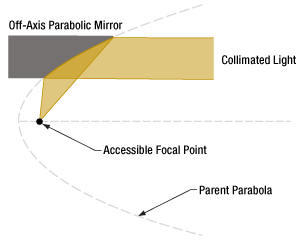
Click to Enlarge
Figure 4: An off-axis parabolic mirror can be thought of as a section of the larger parabolic shape. Both have the same focal point, but it is more accessible in the case of an OAP mirror.
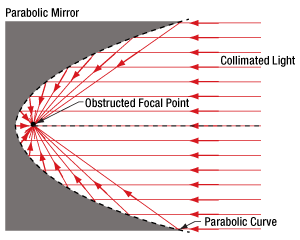
Click to Enlarge
Figure 3: The focal point of an on-axis parabolic mirror is close to the reflective surface, and typically surrounded by the reflective surface, which makes the focal point difficult to access.
One of the primary benefits of a concave parabolic mirror is its single focal point. All rays travelling parallel to the mirror's axis are reflected through this point. This is useful for a range of purposes, including imaging and manufacturing applications that require focusing laser light to a diffraction limited spot.
There are a few negatives associated using with using conventional parabolic mirrors, which are symmetric around the focal point (Figure 3). One is that the sides of the mirror generally obstruct access to the focus. Another is that when the mirror is used to collimate a divergent light source, the housing of the light source blocks a portion of the collimated beam. In particular, light emitted at small angles with respect to the optical axis of the mirror is typically obstructed.
An off-axis parabolic (OAP) mirror (Figure 4) is one solution to this problem. The reflective surface of this mirror is parabolic in shape, but it is not symmetric around the focal point. The reflective surface of the OAP corresponds to a section of the parent parabola that is shifted away from the focal point. The section chosen depends on the desired angle and / or distance between the focal point and the center of the mirror.
Date of Last Edit: Dec. 4, 2019
Directionality of OAP-Mirror-Based Reflective Collimators
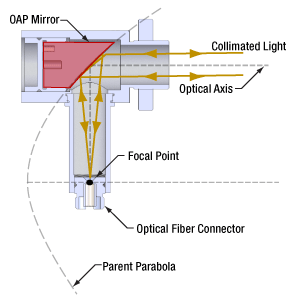
Click to Enlarge
Figure 6: The reflective element of the collimator is an off-axis parabolic mirror. The mirror's substrate is highlighed in red. The shape of the reflective surface is a segment of the parabolic curve displaced from the vertex. The focal points of the parent parabola and the OAP mirror coincide.
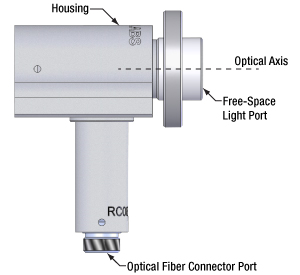
Click to Enlarge
Figure 5: Thorlabs offers reflective collimators that include a port for an optical fiber connector and a port for free space, collimated light that propagates parallel to the optical axis.
The two ports on Thorlabs' reflective collimators are not interchangeable. One port accepts an optical fiber connector and requires the highly divergent light of a point source. The other port is designed solely for collimated, free-space light (Figure 5).
Free Space Port
Light input to this port should be collimated and directed parallel to the optical axis. Diverging light from a fiber end face, a laser diode, or other source should not be input. This light would not be collimated at the fiber connector port or coupled into the fiber connected to the fiber port.
Optical Fiber Connector Port
This port aligns the fiber's end face with the focal point of the mirror. Since the fiber's end face approximates a point source placed at the focal point, a collimated beam is output from the free-space port. The alignment of the fiber end face with the focal point is also the reason that all light input to the free-space light port should be collimated and directed parallel to the optical axis.
Source of Directionality
The collimator's directionality is a consequence of using a non-rotationally symmetric, off-axis parabolic (OAP) mirror as the reflective element (Figure 6). The cut-away view illustrates that the fiber's end face is positioned at the focal point of the parent parabola, which is also the focal point of the OAP mirror.
Date of Last Edit: Dec. 4, 2019
| Posted Comments: | |
Stefan Goppelt
(posted 2025-03-18 08:33:50.697) Do you have any performance data on the beam quality (M2) after collimation (as with your triplet collimators)? Sara Jamshid
(posted 2025-02-17 09:07:54.42) Hello,
What could cause the output beam from a reflective collimator (RC12SMA-P01) to be not completely collimated? This was verified using a shear plate. EGies
(posted 2025-03-07 06:55:11.0) Thank you for contacting Thorlabs. The full angle beam divergence for the RC12SMA-P01 will be dependent on the connected fiber and light source. I have reached out to you directly regarding further troubleshooting. Sebastian Schäfer
(posted 2024-12-03 14:23:47.93) Do you have any values for the tolerances of the RC12FC-P01? Particularly the tolerance on the z distances of the FCPC connector would be intresting. In the past we had to shim this by >100µm to get acceptable results with a single mdoe fiber. eeklund
(posted 2024-12-06 01:57:50.0) Thank you for contacting us! I have contacted you directly via email. user
(posted 2024-09-11 18:57:44.617) What's the insertion loss if I want to couple scattered light into single mode fiber patch cable with these reflective collimators? acanales
(posted 2024-09-13 07:23:17.0) Thank you for contacting Thorlabs! Our reflective collimators are designed to efficiently couple collimated light into fibers. While these collimators may not be optimized for coupling scattered light, we have reached out to you to discuss your application in more detail and explore potential solutions. Kamalesh Dadi
(posted 2024-08-05 09:22:05.093) Hi Thorlabs,
A very cool product for collimating the output from the fibre sources. Is there any possibility of customizing it for further lower focal length values. Like 4mm or 3mm. Kindly send more information to my email, if something is possible in this direction.
Thank you.
Best,
Kamalesh srydberg
(posted 2024-08-07 01:48:53.0) Hi, thank you for your feedback! We have contacted you directly via email. Harim Jeong
(posted 2024-04-04 14:06:12.98) Is there a surface that guarantees a plane perpendicular to the collimated beam? acanales
(posted 2024-04-05 06:01:14.0) Thank you for contacting us! For RCs with FC/APC and FC/PC, we guarantee a pointing error of <10mrad (see specifications). We test it with respect to the housing surface closest to the output of the beam. user
(posted 2024-04-01 08:56:47.533) I am interested in buying the mirror itself without the casing. Do you have them in your catalog? Otherwise, would you be willing to sell them on a request? srydberg
(posted 2024-04-02 08:23:45.0) Hi, thank you for contacting Thorlabs! We offer off-axis parabolic mirrors in the catalog: https://www.thorlabs.com/newgrouppage9.cfm?objectgroup_id=7004
We have contacted you directly for further discussions. 崇史 麻谷
(posted 2024-02-07 22:17:19.867) RC02FC-P01ですが、TO-CANレーザーダイオードのコリメーションに使用したいのですが、筐体やファイバー用のコネクタが邪魔です。除去するか、凹面鏡の周辺部だけ取り出すことは可能でしょうか? acanales
(posted 2024-02-09 07:07:03.0) Thank you for your feedback! We can to some extent offer customized versions of the RCs. Please reach out to your local Tech Support department (techsupport.jp@thorlabs.com) to discuss this further. Ross Harder
(posted 2023-04-28 14:44:55.72) Greetings,
Is there a version of this with an adjustable fiber focal distance? We were thinking to use it to collect light from a small source and get it into a fiber. tberg
(posted 2023-05-02 04:39:18.0) Dear Sir,
Thanks for contacting Thorlabs!
Stock version of the reflective collimators does not feature adjustable fiber focal distance, unfortunately. However, we are looking into that for future development of the reflective collimators. At this time, we can offer custom version with unglued fiber receptacle so customer can adjust fiber focal distance. Please let us know if you are interested in such option. Kévin AFFANNOUKOUE
(posted 2022-11-10 11:26:30.68) Hello, I am trying to couple a LED into a multimode fiber (1mm core diamater). Associated with an aspheric lense to reject the source to infinity, what would be the coupling efficiency into the fiber ? What would be the difference between a short and long RFL ? Also, why is the
RC08SMA-P01 cheaper than the other ones ? Thank you ! fnero
(posted 2022-11-11 04:52:11.0) Thank you for reaching out to us. When coupling LEDs into a fiber, using a large core multimode fiber will usually give good results, but is very difficult to estimate coupling efficiency. To select a proper reflected focal length, you need to calculate it based on the lightning chip area, fiber core diameter and focal length of the collimation lens. The ratio of the fiber core diameter to the lightning area of the LED has to be the same as the ratio of the reflected focal length of the reflective collimator to the focal length of the collimation lens of the LED.
I have reached out to you directly to discuss your application in detail. Price differences between different models are due to varying manufacturing cost. Brandon Chen
(posted 2022-06-16 16:03:46.973) Hello, my pulsed laser source has 33kHz frequency, 200ns width and 8mm beam diameter, the average power is 30W. It's spatial light and I need to couple it in to a SMA fiber. Any recommended collimators to handle such high energy laser beam? Thanks a lot! cdolbashian
(posted 2022-06-21 11:44:45.0) Thank you for reaching out to us! I have contacted you directly to find the best collimator for your laser and application. Roger Perreault
(posted 2022-02-25 11:01:49.94) What is the maximum temperature on the case of the RC08FC-P01 to ensure not to cause internal damage. cdolbashian
(posted 2022-03-08 02:41:28.0) Thank you for reaching out to us Roger. The first component of this collimator to fail would definitely be the adhesive used to secure the mirrors internally. The adhesive works well until 50C but above that would likely fail. I have contacted you directly to ask about your specific application and discuss a potential special using high temp epoxy. OHSOUNG KWON
(posted 2022-01-05 20:26:35.087) Can I order fiber port of RC02APC-P01?
I don't know why Thorlabs doesn't categorized the product in terminated fiber adapters.
All of products for FC/APC in 'Terminated Fiber Adapters' category cannot specify exact position of end face and center of core of ferrule, when assembled with fiber connector in FC/APC. cdolbashian
(posted 2022-01-14 01:28:23.0) Thank you for your inquiry Ohosung. "Terminated fiber adapters" are specifically industry standard fiber optic termination bulkheads which adapt to our standard optomechanical mount threadings, such as SM1, SM2, or RMS. I have contacted you directly to discuss your other inquiries. Tariq Khwaja
(posted 2021-03-29 11:50:22.463) Assalamualaikum.
This question was asked on 2020-10-14 but I am not sure I understood the answer.
Thorlabs sells several lens collimators with fixed focus that can be used as couplers. Of course there is the usual challenge of alignment and mode matching with all such collimators.
However, is there any other reason why using reflective collimators are "... not recommended for coupling ..." into SMF? YLohia
(posted 2021-04-14 10:12:28.0) Hello, as mentioned in the previous response, coupling into a single mode fiber can be quite difficult to do well with a high efficiency. It is possible to use the reflective collimators as a fiber coupler into a single mode fiber. For that you should use a mount with at least tip/tilt adjustment in order to adjust the input angle. These are not specifically recommended for SMF fiber coupling because there is no adjustability between the distance between the mirror and the fiber tip. Because these collimators do not have a focus adjustment it can be helpful to use a multimode fiber with a larger core diameter for a rough angle alignment. Andreas Markwirth
(posted 2021-01-14 11:18:28.993) Hi,
We use the 12 mm reflective output coupler (and a smaller one) and use it with a FC/PC PM single mode fiber, but we observe a stripe-pattern in the collimated beam and also a low-intesity "stripe", probably a reflex, that covers a large angle.
Links to images showing the stripe pattern in the 12 mm beam:
https://abload.de/img/pxl_20210105_145219230zj7g.jpg
and the low intesity stray light:
https://abload.de/img/pxl_20210105_14565362ivkfc.jpg
Is this a known issue or maybe even expected behaviour? nreusch
(posted 2021-01-20 03:59:33.0) Thank you for your feedback. Even when the surface roughness is within specs (roughness <100 Å (RMS)), there can sometimes be seen a diffraction pattern, especially at shorter wavelengths.
The low intensity long line through the beam might be caused by the beam hitting a surface internally in the housing. For the RC12, the NA of the fiber should be less than 0.216 to avoid this.
We will contact you directly to have a more detailed discussion. Bob Pierce
(posted 2020-12-28 11:36:47.817) Have you thought about multimode fiber versions of the reflective collimators? These would mostly decrease the f/# (increase the NA) for standard MM fiber, with NA ~0.22. YLohia
(posted 2020-12-29 03:48:11.0) These collimators are compatible with multimode fibers, depending on the fiber and optic NA. In multiple-wavelength systems operating in the visible and IR, these reflective collimators can be used to both couple polychromatic collimated light into large-core multimode fiber and to collimate polychromatic light emitted by optical fibers. Note that, in general, light from a multimode fiber cannot be well collimated. When collimating light from a multimode patch cable, the fiber NA should be <0.40 (RC02), <0.36 (RC04), <0.167 (RC08), or <0.216 (RC12) to avoid clipping light on the housing. For more information on how to optimize coupling of light from an optical fiber, please see the Collimation Tutorial tab. user
(posted 2020-10-14 17:40:14.88) In the "Collimator Guide" tab, under "Reflective Collimators" it says "Our reflective collimators are ideal for collimating single mode fiber but are not recommended for coupling into single mode fiber." Why are they not recommended for coupling into single mode fibre? Thanks. cwright
(posted 2020-10-19 08:49:32.0) Response from Charles at Thorlabs: Hello and thank you for your query. Coupling into a single mode fibre can be quite difficult to do well. That said, it is possible to use the reflective collimators as a fiber coupler into a single mode fiber. For that you should use a mount with at least tip/tilt adjustment in order to adjust the input angle. Because these collimators do not have a focus adjustment it can be helpful to use a multimode fiber with a larger core diameter for a rough angle alignment.
Your local technical support team will be contact you directly to help with the alignment procedure. user
(posted 2020-06-09 06:38:05.523) Hello, I am using the RC08PC-P01 to inject a collimated beam into a multimode fiber. I am using a cage system and I am currently using 2 tip/tilt mirror mounts and one rotation plateform with mirror to inject the collimated beam into the fiber. I would like to know if all these adjustements are necessary for correct injection into the fiber, or if less adjustements (one or two only) could be sufficient to inject properly the beam into the fiber. Thanks for your help! Best regards YLohia
(posted 2020-06-09 01:50:24.0) Hello, thank you for contacting Thorlabs. For highest fiber-coupling efficiency when using a fixed focus package, we recommend utilizing 4 degrees of freedom (X, y, tip, and tilt) on adjustments on either the input beam or the fiber coupling package itself. In your case, utilizing a two-mirror beam steering method would allow for the 4 types of adjustment, however, this would be a significantly more time consuming alignment procedure than using a multi-axis mount to hold the collimator (for example, the K5X1 mount). Lukas Glandorf
(posted 2020-05-15 07:49:45.997) Hi,
I'm using multiple RC08APC collimators and a beamsplitter to split the output of a single mode fiber into 2 single mode fibers. However, I'm having trouble getting more than 10% coupling when comparing the free space output of the output-collimator with the output of a connected single mode fiber. I'm adjusting the coupling through 2 adjustable mirrors. Any tips on what the problem could be? nreusch
(posted 2020-05-19 11:35:13.0) Thank you for contacting us. To achieve an efficient coupling into a single mode fiber, you will need to have a sensitive alignment system that allows you to control tip and tilt as well as translational adjustments. We have contacted you directly to discuss your setup in detail. LingTong Meng
(posted 2020-03-02 18:24:06.96) When we did the experiment, we passed a beam of white light through the collimator, but we found that the emitted light was diffused and ended up as a diffused circular spot. What caused this? nbayconich
(posted 2020-03-03 01:08:10.0) Thank you for contacting Thorlabs. It will be best to know more details about your setup such as the fiber core size and NA that is currently being used. Note that these collimators can be used with multimode fibers however collimating light from a large fiber core can result in a relatively divergent beam compared to using a single mode fiber. I will reach out to you directly to discuss your application. Lena Waszczuk
(posted 2020-01-22 08:57:30.47) Hello,
I am using the RC08APC-P01 to collimate a 785 nm laser beam from a 0.1 NA PM fiber.
I observe a 20% power loss at the output of the collimator, what could this loss be due to?
I have the same issue using either a 785 nm laser or a broadband source (700-1100 nm). Best regards. YLohia
(posted 2020-01-23 08:37:24.0) Hello, thank you for contacting Thorlabs. Power loss during collimation, in your case, can occur due to incorrect connectors (FC/PC instead of FC/APC), dirt or dust in the collimator, or misalignment of the invisible beam with respect to the power sensor. I have reached out to you directly to troubleshoot this further. Arthur van Wijk
(posted 2019-10-30 09:23:27.96) We were advised to use a RC04 to refocus a collimated beam (simply the reverse of collimating). Unfortunately this does not work. It seems that the spotsize is too big. It doesn't even work with MM fibers. My guess is that this demands a very high beam quality, or is there something else at play? Using a single molded aspheric lens works much better! Of course you need to mount the fiber on a XYZ stage with high precision micrometers, but we now have less absorption than with the objective we used before. We'll keep the RC04FC for whenever we need a collimator. mdiekmann
(posted 2019-11-06 02:07:52.0) Thank you for contacting Thorlabs! In order to optimize the incoupling into a reflective collimator, the collimator should be mounted into a tip/tilt plate. Jan Kaster
(posted 2019-09-11 07:54:47.517) Hi there,
I am thinking about using these for a stray light measuring setup, where a extraordinarily clean beam is required (2% at 633nm is already a bit rough).
Would it be possible to achieve a better surface roughness (e.g. 1nm or at least 5nm) and quality (e.g. 10/5 or at least 20/10)?
Would it be possible to apply a black coating on the inner tubes, e.g. Acktar Magic Black, to reduce stray light from the fiber?
Thanks and kind regards,
Jan wskopalik
(posted 2019-09-18 06:30:28.0) Thank you for contacting Thorlabs.
Unfortunately, we cannot offer higher specifications on Surface Roughness and Surface Quality at this time, but it is certainly possible to apply black coating on the inner tubes as a custom option.
We will contact you directly in this matter. mikael.malmstrom
(posted 2019-01-15 06:56:43.54) I would like to have a 2" reflective (high NA) collimator fibrecoupled for collecting scattered light, with a center hole for illumination also with a fiber coupled reflective collimator (Low NA). Would anyone else like such a thing? nbayconich
(posted 2019-01-21 09:10:31.0) At the moment we cannot provide 2" diameter reflective collimator packages however we can provide customized OAP mirrors to be used for similar applications. The simplest solution would be to use a stock OAP mirror from our catalog along with some of our catalog mirror mounts and terminated fiber adapters located in the links below.
OAP mirrors with through holes https://www.thorlabs.us/newgrouppage9.cfm?objectgroup_id=7197
Right angle OAP mounts https://www.thorlabs.us/newgrouppage9.cfm?objectgroup_ID=11097
Termintated fiber adapters https://www.thorlabs.us/newgrouppage9.cfm?objectgroup_id=69 CMac
(posted 2018-12-19 10:42:19.247) In the collimation tutorial, the quoted beam diameters are measured to 1/e2, is that correct? YLohia
(posted 2018-12-21 10:00:09.0) Hello, the listed values in the 'Collimation Tutorial' tab are calculated from the equation d = 2 x NA x RFL, so the diameter's definition will depend on the definition of NA for the fiber being used. The NA is based off a geometrical angle, and is for the 5% fall-off point from the peak intensity at the center of the beam. kwu
(posted 2018-11-12 20:37:20.347) I have a single mode 0.22 NA SMA fiber. and I want to let the output beam size as small as possible. Should I select RC02SMA-P01? Or RC12SMA-P01(for NA purpose)?
Thank you. YLohia
(posted 2018-11-13 09:25:02.0) Hello, thank you for contacting Thorlabs. In this case, the RC02SMA-P01 would be most suitable for a small beam diameter as it has a higher NA than your fiber and a shorter focal length than the other collimators in this product line. kullock
(posted 2018-09-26 09:53:10.657) We would like to use one of the reflective collimators (probably RC08FC-P01) to couple out light from a photonic crystal (PC) fiber. The issue with PC fibers is that as the last hundred of micrometers are sealed (to prevent water from penetrating the holes) the light already starts to diverge there and, hence, the effective focus is not at the end facet but shifted into the fiber.
So, the collimators cannot deliver collimated light for PC fibers (we tested it with the RC02SMA-P01 & RC04SMA-P01 variants). Would it be possible to have an adjustable fiber position to compensate for that? (This sounds at least tricky as the precisions probably has to be much below 10µm.) nbayconich
(posted 2018-10-01 09:06:28.0) Thank you for contacting Thorlabs. We do not have plans to release an adjustable focus version of the reflective collimator packages at the moment, we can however provide a version of these collimators where the fiber connector bulkhead will not be fixed/glued to the collimator housing allowing the position to be adjusted.
I will reach out to you with more information. user
(posted 2018-09-06 13:16:00.447) What is the damage threshold of these products? nbayconich
(posted 2018-09-06 03:25:55.0) Thank you for contacting Thorlabs. We use the same metallic coatings for these reflective collimators as in the Off axis parabolic mirrors located in the link below.
https://www.thorlabs.com/navigation.cfm?guide_id=2313
The same damage thresholds for these types of coatings on the OAP product page can be used for the reflective collimators, for example the LIDT for the -P01 silver coating will be 3 j/cm^2 @ (1064 nm, 10 ns, 10 Hz, Ø1.000 mm) for pulsed and 1750 W/cm @ (1.064 µm, Ø0.044 mm) &
1500 W/cm @ (10.6 µm, Ø0.339 mm) for CW. This is safe to use when collimating a fiber source.
However your input power limitation when coupling into fiber using the reflective collimator will be limited by the epoxy of the fiber connectors. 300mW is our general rule of thumb for power coupling in to a connectorized fiber. s.grandi
(posted 2018-08-02 18:27:07.667) Hi,
I am using a RC08APC to couple light from a coherent light source into a 1064nm PM fibre (also Thorlabs). However, I am struggling to get past 10% coupling. The mode of the incoming beam is nice and gaussian, and I can achieve up to 70% coupling with a lens. Do you have any advice on this issue?
Thanks YLohia
(posted 2018-08-09 03:19:52.0) Hello, thank you for contacting Thorlabs. There are several factors that can impact the coupling efficiency. For example:
- the input beam diameter and its wavelength
- the collimation level of the input beam
- connector type of the fiber being used. Is it FC/PC connectorized or is it FC/APC?
- the type of mount being used. Based on our discussion, the KM100 you are using is not good enough for high efficiency single mode fiber coupling since it only offers tip and tilt adjustment. You will need z and y axis adjustment in addition to that.
- it is also possible that the mirror is dirty and can require some cleaning jyryu1
(posted 2018-02-26 23:11:27.737) [Customer inspired version of RC02FC-P01) I am wondering if we could have SM2 compatible Reflective Collimators, Protected Silver Coating with final beam diameter of 20~25mm (which would fit into POLARIS-K2S2P).In case of laser we have, we have beam divergence of 220 mrad(PC type). it means 51 mm X 2 X NA ~ 11 mm will be the final beam diameter. Will it be possible? how long will it take? Sincerely
Ji young, RYu llamb
(posted 2018-03-13 09:02:08.0) Hello, thank you for contacting Thorlabs. We should be able to offer a custom collimator, though it will likely have a long lead time that depends on the desired quantity and exact specifications. I will reach out to you directly to discuss this further. niccolo.daddi.ext
(posted 2017-10-24 15:45:30.69) I have the following fiber:
FC fiber I/F, 600um core, 0.22 NA
I need first to collimate it and then, in a second stage of my setup, to take the collimated beam and focalize it into another optic fiber.
Could you please help me in the selection of the right collimator? Thank you. nbayconich
(posted 2017-11-20 11:18:01.0) Thank you for contacting Thorlabs. When using a multimode source we recommend using a collimator with the longest focal length as possible for your application to reduce divergence. Assuming you are coupling back into another fiber with a 600µm core diameter you should use two of the same type collimator with equal focal lengths for collimating and coupling. I will contact you directly to help you find the best solution for your application. lebouquj
(posted 2017-10-03 14:45:17.477) After building reflective collimators for years, we are very pleased to see this product!! Is there any plan for even larger beams (say diameter 20mm) ? Thanks nbayconich
(posted 2017-10-05 09:55:59.0) Thank you for contacting Thorlabs. We have provided reflective collimators with EFL's up to 101.6mm and can provide custom reflective collimators upon request. We have recently seen demand for longer focal length collimators so there may be a possibility of releasing stock versions in the future. I will contact you directly with more information. kjm2
(posted 2017-08-31 18:43:43.617) Hi there,
I am currently using the RC02APC-P01 to collimate a 3 mm diameter laser beam into your SM fibre P3-23Z-FC-2 with NA 0.19 and a 9 um core. I am also using them to collimate the light from the fibre and send it to a detector.
We will be ordering some fibres from another manufacturer with NA 0.23 and a 6.5 um core. Should I be using a reflective collimator with a better matched NA such as the RC04 or even RC12? tfrisch
(posted 2017-09-14 04:55:07.0) Hello, thank you for contacting Thorlabs. Typically, a collimating optic is selected to achieve a given collimated beam diameter. Beam diameter is roughly 2*NA*RFL for a reflective collimator. I will reach out to you directly about your application. nisanns
(posted 2017-04-24 15:15:43.593) when using the RC04SMA-P01 to collimate the output of a MM fiber, the collimated beam diameter in the provided table is listed as being from a 0.13 NA fiber. how does that scale if using a 0.39 NA fiber? is it linear with NA (maybe 2*effective focal length*fiber NA)? can you provide the method used to calculate the beam diameter? thanks much tfrisch
(posted 2017-05-02 11:14:44.0) Hello, thank you for contacting Thorlabs. The relationship is trigonometric, but that is often approximated as linear for small angles. the NA defines the divergence angle; NA=n*sin(theta) where n=1 for air. Theta is the half angle of divergence, RFL is the adjacent side, and you can solve for the opposite side length of a right triangle which is half of the beam diameter. I will reach out to you directly to discuss further. christoph.kratz
(posted 2017-03-07 01:49:03.59) I would like to couple a MIR source (5-10µm) into a fiber. Therefore I am interested in what kind of coating is used for silver protection? Is there an uncoated alternative like alluminium or gold for the surface of the mirror? tfrisch
(posted 2017-03-23 01:17:30.0) Hello, thank you for contacting Thorlabs. The protective coating is SiO2, but we can likely offer a version with unprotected gold for your application. I will reach out to you directly about details for a quote. dirk.lorenser
(posted 2016-03-21 20:16:33.827) I can see from your feedback comments that you align these collimators using a shearing interferometer at 540nm wavelength. Can you give me a spec for the wavefront error (deviation from a plane wavefront) which you achieve using this technique (e.g. lambda/10 over the specified output beam diameter) ? The reason I'm asking is because I'd like to use the RC12APC-P01 as a "plane wave" reference for a test setup. Thanks. besembeson
(posted 2016-03-25 08:40:04.0) Response from Bweh at Thorlabs USA: I will contact you with this specification. johannes.walter
(posted 2015-08-27 17:02:43.95) Thank you very much for your reply. Unfortunately, I did not receive any email so far. Might it got lost? besembeson
(posted 2015-08-28 08:42:31.0) Response from Bweh at Thorlabs USA: Our Germany team fielded this request and has obtained the data. I will provide it to you via email. johannes.walter
(posted 2015-07-21 19:13:00.247) Could you offer the RC02SMA with the UV enhanced protected aluminum? besembeson
(posted 2015-08-19 03:05:06.0) Response from Bweh at Thorlabs USA: We can provide this to you. I will followup by email. david.panak
(posted 2015-02-18 12:34:00.52) which version of the collimator (SMA, APC, or FC)has a mechanical stop for the end of the fiber ferrule? I do not want the focal lenght of the collimator to change based upon how much the fiber ferrule was polished. thank you cdaly
(posted 2015-02-24 04:29:20.0) Response from Chris at Thorlabs: FC/PC and FC/APC fibers have spring loaded ferrules which will push against a hard stop in the bulkhead of the compatible collimators. SMA fiber connectors do not feature this. The ferrule will go in as far as it will based on where the fiber is when it is tightened down. That's not to say that the SMA connector would not still be held to a tight tolerance on the location of it's end face though. czl0579
(posted 2014-12-05 16:14:07.957) We find the surface roughness is <10nm. This should be very smooth. But when we unplug the SM fiber a little bit (therefore the output beam is divergent) and put a white board infront of the collimator, we can see the beam profile is not uniform. There seems some scratchs. Dose it make sense? jlow
(posted 2015-01-12 04:23:37.0) Response from Jeremy at Thorlabs: We have contacted you directly to discuss about the measurement of the surface roughness. clarafly
(posted 2014-09-15 01:56:44.963) I want to collimate a 1550-nm light from a SMF28 fiber, reflect the light with a mirror, and then couple it back to the same fiber. The mirror can be placed very close to the collimator. What's the expected coupling efficiency if I use these reflective collimators? Is it possible to reach 80%? johannes.walter
(posted 2014-08-22 15:02:59.38) Hello, I would like to ask you how you assure the correct distance between the fiber core and the mirror. To my experience, the ferrule length of the fiber can vary depending on the fiber and manufacturer. Thank you! jlow
(posted 2014-08-28 03:14:19.0) Response from Jeremy at Thorlabs: For alignment, a shearing interferometer is used to ensure collimation. We use the S460-HP fiber at 543nm during production. chmpengb
(posted 2014-07-16 14:44:01.293) I don't see this RC0x series collimating lens having any features that allows us to fine tune the focal length from the input fiber, thus my feeling that the output quality - though the beam will be more converg, will not be so parallel /collimated, Is my opinion right?
I indeed concern whether it is able to achieve a real collimated beam. Please tell me. thanks jlow
(posted 2014-08-07 02:06:42.0) Response from Jeremy at Thorlabs: The focal length of the mirror is constant across the wavelength range so you do not need to fine tune this for different wavelength. The correct distance between the bulkhead and the mirror is set during production so that one would get a collimated output beam from a fiber. tbd8
(posted 2014-07-01 16:12:04.577) Hello, do you have zemax models of these collimators? myanakas
(posted 2014-07-08 10:53:41.0) Response from Mike at Thorlabs: Thank you for your feedback. I have contacted you to provide you with the Zemax files for these collimators. Based on this feedback, we are working to have this information available on the website shortly. sivelinu
(posted 2014-06-28 13:58:04.19) Could I receiving collimated beam with different collimator?(from RC02FC-P01 to TC12FC780) jlow
(posted 2014-08-07 08:40:54.0) Response from Jeremy at Thorlabs: The reflective collimator is generally used with MM fiber whereas the triplet collimator is generally used with SM fiber. If you are collimating the output from a MM fiber and coupling that into SM fiber, this would not work well. I will contact you directly to discuss more about what your application. sivelinu
(posted 2014-06-18 11:50:11.96) Hi. Could you tell me which collimator is suitable for me? I'm planning to have an experiment.
- Collimated beam is launched from collimator and is reflected by mirror and come into collimator again. besembeson
(posted 2014-06-19 10:56:28.0) Response from Bweh at Thorlabs - USA: Thanks for contacting Thorlabs. Yes that can be used for such an application. To optimize coupling back to fiber, you will need kinematic adjustment either on the collimator or reflecting mirror or both. For the RC04FC-P01, the KM05 (http://www.thorlabs.hk/thorproduct.cfm?partnumber=KM05) can be considered. We also have fixed aspheric lens collimation packages that you may consider for your application: http://www.thorlabs.hk/navigation.cfm?guide_id=2235 joachim.fischer
(posted 2014-05-09 09:09:28.437) Hi.
Can you give some information on the beam profile one can expect from your reflectors when using a SM fiber in the visible? Some graphs, or M^2 values? Thanks in advance. jlow
(posted 2014-05-12 01:33:05.0) Response from Jeremy at Thorlabs: We will measure the beam profile from a SM fiber and send it to you directly. codrut.raduta
(posted 2014-02-23 01:34:13.653) Hello, I am trying to couple a 120 W, 1940 nm laser, 5.5 - 6 mm beam diameter into a SMA connector fiber (NA = 0.22, fiber diameter 200-800 microns). May a reflective collimator be used on reverse, from a given laser beam into fiber? Will RC08SMA-01 work on that? Do you have any other suggestions? Like a custom made coupler with clear aperture big enough to accomodate our laser beam diameter? Thank you. Cody besembeson
(posted 2014-02-28 04:59:22.0) Response from Bweh E at Thorlabs: Yes the RC08SMA-P01 can be used for your application. You may also consider our large beam diameter air-spaced doublet collimators, such as the F810SMA-2000. The stock model is aligned for 2um but we can provide a custom version aligned for 1940nm. czl0579
(posted 2014-01-03 18:57:00.317) Hi, I want to couple a collimated white light source (600-800 nm) into a fiber. Which collimator will have a better efficiency, the reflective collimators, triplet fiber optic collimators or achromatic fiberports? Thanks a lot! jlow
(posted 2014-01-20 04:01:34.0) Response from Jeremy at Thorlabs: The choice of the collimator depends on a few things, especially the fiber and the light source used. The reflective collimator offers truly achromatic performance and also a large aperture over the achromatic FiberPort and the triplet collimator. The achromatic FiberPort has X, Y, Z, tip, and tilt adjustment in a very compact package. However, you could also put the reflective collimator on a kinematic mounts for further alignment. I will contact you directly to discuss about your application in more detail. grakes
(posted 2013-08-13 16:11:24.943) Could you offer the RC02 with the UV enhanced protected aluminum? jlow
(posted 2013-08-15 16:15:00.0) Response from Jeremy at Thorlabs: We could possibly offer this. We will contact with you directly for the quote. user
(posted 2013-07-19 17:55:11.403) Hi, I have a 1000 µm core diameter fiber with 0.22 NA. Will the RC12 work properly with such large fiber core? Thanks and regard. Frederic cdaly
(posted 2013-07-24 13:44:00.0) Response from Chris at Thorlabs: Thank you for using our feedback tool. The reflective collimators will still work well, but not quite as well as with a single mode (~5-10 um core) 0.12 NA fiber. The beam size and divergence will be larger than what it specified for these fibers. Longer focal length collimators may be susceptible to come attenuation if the NA of the fiber is too large and the beam is clipped on the parabolic mirror inside. johannes.walter
(posted 2013-07-03 17:05:54.04) I have the same question the user "pain" had almost 2 years ago:
Would it be possible to offer collimators using a mirror with a smaller focal length to obtain a 2 mm beam diameter?
My setup: SMA-905 fiber connector, 200 µm core, NA=0.22, necessary wavelength range: 200 - 1200 nm cdaly
(posted 2013-07-03 11:10:00.0) Response from Chris at Thorlabs: Thank you for your feedback. We do have an RC02 reflective collimator in the design stage at the moment which will create about a 2mm beam diameter. Unfortunately there is no set date for release at the moment yet. schaefer
(posted 2013-06-12 15:57:29.273) Below you give a formular for the divergence of the beam:
divergence = arctan (Core Diameter in mm / EFL in mm)
how precise is this and where can I find information about how to derive this equation?
thanks a lot! pbui
(posted 2013-06-13 16:42:00.0) Response from Phong at Thorlabs: The divergence can be found by tracing a ray from the bottom edge of the fiber core through the top edge of the lens. Applying the thin lens approximation will yield the approximate equation. More sophisticated ray tracing techniques can solve for the divergence more accurately. syim
(posted 2013-05-14 22:00:04.577) I was very happy to see this product, since I had a hope to collimate UV beams easily. But when I tried it, I was disappointed. The output beam is not a smooth beam, but has complicated structures like many grains. It makes me embarrassed since I had not noticed any description about the beam quality. jlow
(posted 2013-05-15 11:19:00.0) Response from Jeremy at Thorlabs: I apologize for the issue you are having. I will get in contact with you to discuss more about your applications and troubleshoot this. andrea.dellapatria
(posted 2013-03-13 07:38:08.757) Could you please tell me if RC04SMA-P01 may work well with an SMA multimode fiber bundle (N.A.=0.22)?
Thanks a lot
Regards
Andrea
___ tcohen
(posted 2013-03-21 15:01:00.0) Response from Tim at Thorlabs to Andrea: The RC04SMA-P01 shouldn’t clip your beam with that NA fiber. However, the collimation performance will suffer as the core size gets larger. To be able to see if it’s suitable we would also need to know your core size and the maximum divergence angle that your application is able to accept. I will contact you to discuss this in the context of your setup. jlow
(posted 2012-08-29 17:05:00.0) Response from Jeremy at Thorlabs: Thank you very much for your feedback. The output beam diameter is dependent on both the focal length and the numerical aperture (NA) of your fiber. The beam diameter specified online is based on a 0.13NA fiber. I will get in contact with you to discuss about your application. bmangum
(posted 2012-08-24 10:56:05.0) I am very happy to discover that these collimators are being offered. I would like to use them for microscopy applications (I imagine many other customers also). Many Microscope objectives have a back aperture diameter in the range of ~5-5.5 mm. It would be fantastic if you were offering this product that could directly yield a beam with a 5.5 mm diameter as this would allow direct use of the beam without further conditioning as it is desirable to fill (or slightly overfill) the back aperture of the objective with a collimated laser beam. Might you consider offering these products with more beam diameters? tcohen
(posted 2012-05-09 15:17:00.0) Response from Tim at Thorlabs: Thank you for your feedback! I will open a discussion regarding your idea with our production team. About 1/3 of our products are customer inspired and we appreciate you sharing your product idea as we continue to expand our catalog. lg
(posted 2012-05-07 20:26:36.0) Thor labs should really offer their 2 inch and 1 inch off-axis parabolas in a similar setup as RC12SMA. There have been so many times in the last 6 years I have wanted a plug and play parabola for a large core fiber collimated output. Offering the mounts are well and good, but have a well machined and aligned part that just drops into the Thor Labs cage mount system would save a lot of time and hassle. bdada
(posted 2011-10-06 17:08:00.0) Response from Buki at Thorlabs:
Thank you for your feedback. We will contact you directly to discuss your application. pain
(posted 2011-10-06 10:50:33.0) Would it be possible for Thorlabs to offer collimators using a mirror with a smaller focal length to obtain a 2mm beam diameter using the same fiber ? jjurado
(posted 2011-06-16 15:22:00.0) Response from Javier at Thorlabs to freedayback: Thank you for contacting us. The formula we provide for the output beam diameter is simply a rough approximation, which assumes the output of the fiber to be a point source and is helpful for getting an idea of the required focal length and clear aperture of the collimating lens. As the core of the fiber increases, this approximation becomes less accurate, since the core can no longer be considered a point source. This is also why we recommend limiting the numerical aperture when using multimode fibers. Nonetheless, there are more robust formulas available that you could use. I will contact you directly for further support. freedayback
(posted 2011-06-16 08:01:05.0) its said that "output diameter=2*NA(fiber)*EFL?
would the fibers core diameter affect the output diameter? bdada
(posted 2011-04-26 17:52:00.0) Response from Buki at Thorlabs:
Thank you for your feedback. I am sorry to hear you've had problems using our reflective collimator. We have contacted you to get more information about your fiber and laser source so we can give you a better estimate of the coupling efficiency. mike.staniforth
(posted 2011-04-26 12:21:55.0) Hi I purchased one of these collimators for use in the mid IR. Laser beam of 1/e2 of ~5mm I have struggle to acheive any decent collimation onto my fibre (for which a lens set acheived 4 to 5 times the power collected). Do you know what might be going wrong - can I return? Greg
(posted 2011-01-13 10:54:22.0) A response from Greg at Thorlabs:You can estimate divergence with the following formula: divergence = arctan (Core Diameter in mm / EFL in mm) user
(posted 2011-01-12 21:31:30.0) Is there a simple way to estimate beam divergence from a multimode fiber for these collimators? tor
(posted 2010-12-07 14:11:33.0) Response from Tor at Thorlabs to day: Thank you for your interest in our reflective collimators. We will be soon releasing the RC04-series, which will include a 0.36 NA and will be available with APC receptacles. Subscribing to our new product RSS feed will allow you to track the release of these collimators: http://www.thorlabs.com/feeds.cfm day
(posted 2010-12-06 10:33:20.0) Hi, did you create an FC/APC version in the end? I would also be interested in such a version. Also, is it possible to get this collimator with a higher NA (~0.25)? klee
(posted 2009-11-24 16:36:50.0) A response from Ken at Thorlabs to mdefensor: The RC08FC is for FC/PC only. However, we are preparing to launch a APC version and could possibly make a special in 3 -4 weeks time. mdefensor
(posted 2009-11-20 23:57:20.0) Hi I would like to ask if it is possible to use an FC/APC fiber connector for this collimator. We are planning to use it as a collector for a fiber coupled imaging spectrometer. We would like to use an APC connector on the collection side to minimize back reflections which causes unwanted interference patterns in our obtained spectra. |
Fiber Collimator Selection Guide
Click on the collimator type or photo to view more information about each type of collimator.
| Type | Description | |
|---|---|---|
| Fixed FC, APC, or SMA Fiber Collimators | 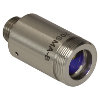 |
These fiber collimation packages are pre-aligned to collimate light from an FC/PC-, FC/APC-, or SMA-terminated fiber. Each collimation package is factory aligned to provide diffraction-limited performance for wavelengths ranging from 405 nm to 4.55 µm. Although it is possible to use the collimator at detuned wavelengths, they will only perform optimally at the design wavelength due to chromatic aberration, which causes the effective focal length of the aspheric lens to have a wavelength dependence. |
| Air-Spaced Doublet, Large Beam Collimators | 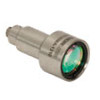 |
For large beam diameters (Ø5.3 - Ø8.5 mm), Thorlabs offers FC/APC, FC/PC, and SMA air-spaced doublet collimators. These collimation packages are pre-aligned at the factory to collimate a laser beam propagating from the tip of an FC or SMA-terminated fiber and provide diffraction-limited performance at the design wavelength. |
| Triplet Collimators | 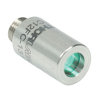 |
Thorlabs' High Quality Triplet Fiber Collimation packages use air-spaced triplet lenses that offer superior beam quality performance when compared to aspheric lens collimators. The benefits of the low-aberration triplet design include an M2 term closer to 1 (Gaussian), less divergence, and less wavefront error. |
| Achromatic Collimators for Multimode Fiber | 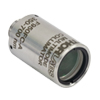 |
Thorlabs' High-NA Achromatic Collimators pair a meniscus lens with an achromatic doublet for high performance across the visible to near-infrared spectrum with low spherical aberration. Designed for use with high-NA multimode fiber, these collimators are ideal for Optogenetics and Fiber Photometry applications. |
| Reflective Collimators | 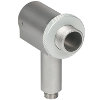 |
Thorlabs' metallic-coated Reflective Collimators are based on a 90° off-axis parabolic mirror. Mirrors, unlike lenses, have a focal length that remains constant over a broad wavelength range. Due to this intrinsic property, a parabolic mirror collimator does not need to be adjusted to accommodate various wavelengths of light, making them ideal for use with polychromatic light. Our fixed reflective collimators are recommended for collimating single and multimode fiber and coupling into multimode fiber. These collimators are available with UV-enhanced aluminum or protected silver reflective coatings and with FC/PC, FC/APC, or SMA connector compatibility. |
| Compact Reflective Collimators |  |
Thorlabs' Compact Reflective Collimators incorporate a 90° off-axis parabolic mirror with a protected silver coating. Because the focal length is independent of wavelength for an off-axis parabolic mirror, they are ideal for use with polychromatic light. Our fixed reflective collimators are recommended for collimating single and multimode fiber and coupling into multimode fiber. These collimators are directly compatible with our 16 mm cage system. They are available with FC/PC, FC/APC, or SMA connector inputs. |
| Adjustable Reflective Collimators | 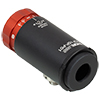 |
Thorlabs' Adjustable Focus Reflective Collimators use a 90° off-axis parabolic (OAP) mirror with a protected silver coating to collimate light from a fiber or couple light into a fiber. The adjustable fiber-to-OAP distance, combined with the OAP having a constant focal length across wavelengths, makes these collimators ideal for optimizing collimation or coupling of polychromatic light with single mode or multimode fiber. These adjustable collimators have a 15.0 mm or 33.0 mm reflected focal length and are available with FC/PC, FC/APC, or SMA connectors. |
| FiberPorts | 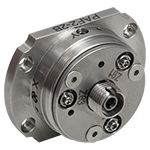 |
These compact, ultra-stable FiberPort micropositioners provide an easy-to-use, stable platform for coupling light into and out of FC/PC, FC/APC, or SMA terminated optical fibers. It can be used with single mode, multimode, or PM fibers and can be mounted onto a post, stage, platform, or laser. The built-in aspheric or achromatic lens is available with five different AR coatings and has five degrees of alignment adjustment (3 translational and 2 pitch). The compact size and long-term alignment stability make the FiberPort an ideal solution for fiber coupling, collimation, or incorporation into OEM systems. |
| Adjustable Fiber Collimators |  |
These collimators are designed to connect onto the end of an FC/PC, FC/APC, or SMA connector and contain an AR-coated aspheric lens. The distance between the aspheric lens and the tip of the fiber can be adjusted to compensate for focal length changes or to recollimate the beam at the wavelength and distance of interest. |
| Achromatic Fiber Collimators with Adjustable Focus |  |
Thorlabs' Achromatic Fiber Collimators with Adjustable Focus are designed with an effective focal length (EFL) of 20 mm, 40 mm, or 80 mm, have optical elements broadband AR coated for one of three wavelength ranges, and are available with FC/PC, FC/APC, or SMA905 connectors. A four-element, air-spaced lens design produces superior beam quality (M2 close to 1) and less wavefront error when compared to aspheric lens collimators. These collimators can be used for free-space coupling into a fiber, collimation of output from a fiber, or in pairs for collimator-to-collimator coupling over long distances, which allows the beam to be manipulated prior to entering the second collimator. |
| Zoom Fiber Collimators | 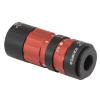 |
These collimators provide a variable focal length between 6 and 18 mm, while maintaining the collimation of the beam. As a result, the size of the beam can be changed without altering the collimation. This universal device saves time previously spent searching for the best suited fixed fiber collimator and has a very broad range of applications. They are offered with FC/PC, FC/APC, or SMA905 connectors with three different antireflection wavelength ranges to choose from. |
| Single Mode Pigtailed Collimators | 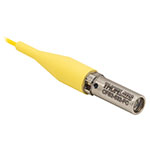 |
Our single mode pigtailed collimators come with one meter of fiber, consist of an AR-coated aspheric lens pre-aligned with respect to a fiber, and are collimated at one of eight wavelengths: 532 nm, 633 nm, 780 nm, 850 nm, 1030 nm, 1064 nm, 1310 nm, or 1550 nm. Although it is possible to use the collimator at any wavelength within the coating range, the coupling loss will increase as the wavelength is detuned from the design wavelength. |
| Polarization Maintaining Pigtailed Collimators | 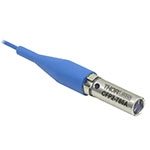 |
Our polarization maintaining pigtailed collimators come with one meter of fiber, consist of an AR-coated aspheric lens pre-aligned with respect to a fiber, and are collimated at one of five wavelengths: 633 nm, 780 nm, 980 nm, 1064 nm, or 1550 nm. Custom wavelengths and connectors are available as well. A line is engraved along the outside of the housing that is parallel to the fast axis. As such, it can be used as a reference when polarized light is launched accordingly. Although it is possible to use the collimator at any wavelength within the coating range, the coupling loss will increase as the wavelength is detuned from the design wavelength. |
| GRIN Fiber Collimators | 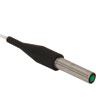 |
Thorlabs offers gradient index (GRIN) fiber collimators that are aligned at a variety of wavelengths from 630 to 1550 nm and have either FC terminated, APC terminated, or unterminated fibers. Our GRIN collimators feature a Ø1.8 mm clear aperture, are AR-coated to ensure low back reflection into the fiber, and are coupled to standard single mode or graded-index multimode fibers. |
| GRIN Lenses | 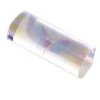 |
These graded-index (GRIN) lenses are AR coated for applications at 630, 830, 1060, 1300, or 1560 nm that require light to propagate through one fiber, then through a free-space optical system, and finally back into another fiber. They are also useful for coupling light from laser diodes into fibers, coupling the output of a fiber into a detector, or collimating laser light. Our GRIN lenses are designed to be used with our Pigtailed Glass Ferrules and GRIN/Ferrule sleeves. |

- 2.2 mm Wide Key FC/PC Connector
- Reflected Focal Lengths of 7.0 mm, 15.0 mm, 33.0 mm, or 50.8 mm
- Externally Threaded Aperture: Ø1/2" Lens Tube Compatible (Item Numbers Starting with RC02, RC04, and RC08), or Ø1" Lens Tube Compatible (Item Numbers Starting with RC12)
| Reflective Collimator Specifications | ||||
|---|---|---|---|---|
| Item #a | RFLb | Max Fiber NAc | Typical Collimated Beam Diameter (1/e2)d | Full Angle Beam Divergencee |
| RC02FC-P01 | 7.0 mm | 0.40 | Ø1.5 mm (SM400 at 450 nm) Ø1.3 mm (SM600 at 633 nm) Ø1.5 mm (780HP at 780 nm) Ø1.3 mm (SMF-28-J9 at 1550 nm) Ø2.2 mm (SM1950 at 2 µm) |
0.023° (SM400 at 450 nm) 0.035° (SM600 at 633 nm) 0.037° (780HP at 780 nm) 0.088° (SMF-28-J9 at 1550 nm) 0.067° (SM1950 at 2 µm) |
| RC04FC-P01 | 15.0 mm | 0.30 | Ø3.1 mm (SM400 at 450 nm) Ø2.8 mm (SM600 at 633 nm) Ø3.3 mm (780HP at 780 nm) Ø2.9 mm (SMF-28-J9 at 1550 nm) Ø4.7 mm (SM1950 at 2 µm) |
0.011° (SM400 at 450 nm) 0.016° (SM600 at 633 nm) 0.018° (780HP at 780 nm) 0.040° (SMF-28-J9 at 1550 nm) 0.031° (SM1950 at 2 µm) |
| RC08FC-P01 | 33.0 mm | 0.15 | Ø6.8 mm (SM400 at 450 nm) Ø6.2 mm (SM600 at 633 nm) Ø7.2 mm (780HP at 780 nm) Ø6.3 mm (SMF-28-J9 at 1550 nm) Ø10.2 mm (SM1950 at 2 µm) |
0.005° (SM400 at 450 nm) 0.007° (SM600 at 633 nm) 0.008° (780HP at 780 nm) 0.018° (SMF-28-J9 at 1550 nm) 0.014° (SM1950 at 2 µm) |
| RC12FC-P01 | 50.8 mm | 0.19 | Ø10.5 mm (SM400 at 450 nm) Ø9.5 mm (SM600 at 633 nm) Ø11.0 mm (780HP at 780 nm) Ø9.6 mm (SMF-28-J9 at 1550 nm) Ø15.8 mm (SM1950 at 2 µm) |
0.003° (SM400 at 450 nm) 0.005° (SM600 at 633 nm) 0.005° (780HP at 780 nm) 0.012° (SMF-28-J9 at 1550 nm) 0.009° (SM1950 at 2 µm) |

- 2.2 mm Wide Key FC/APC Connector
- Reflected Focal Lengths of 7.0 mm, 15.0 mm, 33.0 mm, or 50.8 mm
- Externally Threaded Aperture: Ø1/2" Lens Tube Compatible (Item Numbers Starting with RC02, RC04, and RC08), or Ø1" Lens Tube Compatible (Item Numbers Starting with RC12)
| Reflective Collimator Specifications | ||||
|---|---|---|---|---|
| Item #a | RFLb | Max Fiber NAc | Typical Collimated Beam Diameter (1/e2)d | Full Angle Beam Divergencee |
| RC02APC-P01 | 7.0 mm | 0.40 | Ø1.5 mm (SM400 at 450 nm) Ø1.3 mm (SM600 at 633 nm) Ø1.5 mm (780HP at 780 nm) Ø1.3 mm (SMF-28-J9 at 1550 nm) Ø2.2 mm (SM1950 at 2 µm) |
0.023° (SM400 at 450 nm) 0.035° (SM600 at 633 nm) 0.037° (780HP at 780 nm) 0.088° (SMF-28-J9 at 1550 nm) 0.067° (SM1950 at 2 µm) |
| RC04APC-P01 | 15.0 mm | 0.30 | Ø3.1 mm (SM400 at 450 nm) Ø2.8 mm (SM600 at 633 nm) Ø3.3 mm (780HP at 780 nm) Ø2.9 mm (SMF-28-J9 at 1550 nm) Ø4.7 mm (SM1950 at 2 µm) |
0.011° (SM400 at 450 nm) 0.016° (SM600 at 633 nm) 0.018° (780HP at 780 nm) 0.040° (SMF-28-J9 at 1550 nm) 0.031° (SM1950 at 2 µm) |
| RC08APC-P01 | 33.0 mm | 0.15 | Ø6.8 mm (SM400 at 450 nm) Ø6.2 mm (SM600 at 633 nm) Ø7.2 mm (780HP at 780 nm) Ø6.3 mm (SMF-28-J9 at 1550 nm) Ø10.2 mm (SM1950 at 2 µm) |
0.005° (SM400 at 450 nm) 0.007° (SM600 at 633 nm) 0.008° (780HP at 780 nm) 0.018° (SMF-28-J9 at 1550 nm) 0.014° (SM1950 at 2 µm) |
| RC12APC-P01 | 50.8 mm | 0.19 | Ø10.5 mm (SM400 at 450 nm) Ø9.5 mm (SM600 at 633 nm) Ø11.0 mm (780HP at 780 nm) Ø9.6 mm (SMF-28-J9 at 1550 nm) Ø15.8 mm (SM1950 at 2 µm) |
0.003° (SM400 at 450 nm) 0.005° (SM600 at 633 nm) 0.005° (780HP at 780 nm) 0.012° (SMF-28-J9 at 1550 nm) 0.009° (SM1950 at 2 µm) |

- SMA Connectors Ideal for Multimode Fiber
- Reflected Focal Lengths of 7.0 mm, 15.0 mm, 33.0 mm, or 50.8 mm
- Externally Threaded Aperture: Ø1/2" Lens Tube Compatible (Item Numbers Starting with RC02, RC04, and RC08), or Ø1" Lens Tube Compatible (Item Numbers Starting with RC12)
| Reflective Collimator Specifications | ||||
|---|---|---|---|---|
| Item #a | RFLb | Max Fiber NAc | Typical Collimated Beam Diameter (1/e2)d | Full Angle Beam Divergencee |
| RC02SMA-P01 | 7.0 mm | 0.40 | Ø1.5 mm (SM400 at 450 nm) Ø1.3 mm (SM600 at 633 nm) Ø1.5 mm (780HP at 780 nm) Ø1.3 mm (SMF-28-J9 at 1550 nm) Ø2.2 mm (SM1950 at 2 µm) |
0.023° (SM400 at 450 nm) 0.035° (SM600 at 633 nm) 0.037° (780HP at 780 nm) 0.088° (SMF-28-J9 at 1550 nm) 0.067° (SM1950 at 2 µm) |
| RC04SMA-P01 | 15.0 mm | 0.30 | Ø3.1 mm (SM400 at 450 nm) Ø2.8 mm (SM600 at 633 nm) Ø3.3 mm (780HP at 780 nm) Ø2.9 mm (SMF-28-J9 at 1550 nm) Ø4.7 mm (SM1950 at 2 µm) |
0.011° (SM400 at 450 nm) 0.016° (SM600 at 633 nm) 0.018° (780HP at 780 nm) 0.040° (SMF-28-J9 at 1550 nm) 0.031° (SM1950 at 2 µm) |
| RC08SMA-P01 | 33.0 mm | 0.15 | Ø6.8 mm (SM400 at 450 nm) Ø6.2 mm (SM600 at 633 nm) Ø7.2 mm (780HP at 780 nm) Ø6.3 mm (SMF-28-J9 at 1550 nm) Ø10.2 mm (SM1950 at 2 µm) |
0.005° (SM400 at 450 nm) 0.007° (SM600 at 633 nm) 0.008° (780HP at 780 nm) 0.018° (SMF-28-J9 at 1550 nm) 0.014° (SM1950 at 2 µm) |
| RC12SMA-P01 | 50.8 mm | 0.19 | Ø10.5 mm (SM400 at 450 nm) Ø9.5 mm (SM600 at 633 nm) Ø11.0 mm (780HP at 780 nm) Ø9.6 mm (SMF-28-J9 at 1550 nm) Ø15.8 mm (SM1950 at 2 µm) |
0.003° (SM400 at 450 nm) 0.005° (SM600 at 633 nm) 0.005° (780HP at 780 nm) 0.012° (SMF-28-J9 at 1550 nm) 0.009° (SM1950 at 2 µm) |
 Products Home
Products Home

















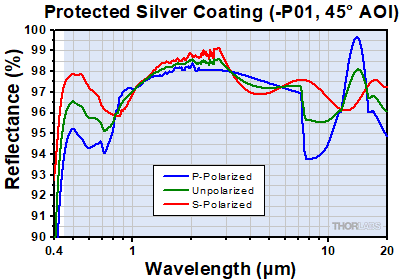


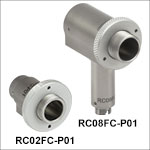
 Zoom
Zoom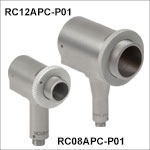
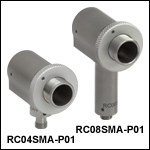
 Protected Silver Reflective Collimators
Protected Silver Reflective Collimators